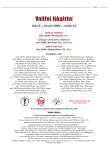Preparation of patients with haemostatic disorder for invasive medical interventions
Authors:
M. Penka 1; A. Buliková 1; P. Smejkal 1; J. Kissová 1; M. Matýšková 1; J. Gumulec 2; S. Králová 2; M. Šlechtová 1; G. Chlupová 1
Authors‘ workplace:
Univerzitní centrum pro trombózu a hemostázu MU Brno a Oddělení klinické hematologie FN Brno, pracoviště Bohunice, přednosta prof. MUDr. Miroslav Penka, CSc.
1; Onkologické centrum J. G. Mendla Nový Jičín, přednosta prim. MUDr. Jaromír Gumulec
2
Published in:
Vnitř Lék 2008; 54(6): 632-637
Category:
Reviews
Předneseno na XIII. Pařízkových dnech s mezinárodní účastí " Diagnostika a léčba krvácení v praxi", konaných v Novém Jičíně ve dnech 15. a 16.3.2007
Overview
The current trend in medicine is to sustain the possibility for necessary procedures to be performed in patients who suffer from haemostatic disorders which complicate eventual surgery. Among such disorders are congenital blood coagulation disorders, haemostatic disorders concomitant with other diseases and also therapies which affect haemostasis either on purpose or as part of adverse effects. Among coagulation disorders are congenital haemorrhagic or thrombotic conditions, acquired blood coagulation disorders – combined in the vast majority of cases – and associated with pregnancy, severe internal diseases and surgery related diseases, severe injuries, wounds, burns, malignancies, systemic connective tissue diseases, inflammatory bowel disease, and a number of other diseases. A separate issue is that of anticoagulation therapy – both antiplatelet, used in the treatment or prevention of venous thrombosis, and anticoagulation, predominantly used to manage venous thromboembolism. Also considered should be any therapy which may have a negative impact on coagulation due to its adverse effects.
Key words:
surgery – haemorrhage – thrombosis – transfusion preparations – blood derivatives – heparin – warfarin
Sources
1. Bates SM, Weitz JL. The status of new anticoagulants. Br J Haematol 2006; 1345: 3-19.
2. Bick RL. Therapy for Venous Thrombosis: Guidelines for Competent and Cost-effective Approach. Unresolved Issues and Proposed Guidelines. Clin Appl Thrombosis/Hemostasis 1999; 5: 2-9.
3. Bulik O. Problematika stomatochirurgického ošetření v průběhu antikoagulační terapie. Čes Stomat 2003; 103: 102-106.
4. Kessler P. Léčba orálními antikoagulancii. Praha: Orion - yhtymä Oyj, Orion Pharma 2002.
5. Knotke-Marchant K. Laboratory diagnosis of hemorrhagic and thrombotic disorders. Diagnostic hematology. Hematol Oncol Clin North Am 1994; 8: 809-853.
6. Kaftan M, Tuddenham E. Assessing thrombotic risk. Br Med J 1998; 317: 520-523.
7. Levine MN, Raskob G, Betty RJ et al. Hemorrhagic Complications of Anticoagulant Treatment. The Seventh ACCP Conference on Antithrombotic and Thrombolytic Therapy. Chest 2004; 126: 287-310.
8. Makris M, Graeves M, Philips W et al. Emergency oral anticoagulant reversal: the relative efficacy of infusions of fresh frozen plasma and clotting factor concentrate on correction of the coagulopathy. Tromb Haemost 1996; 77: 477-480.
9. Marder VJ, Rosove MH, Minning DM. Foundation and sites of action of antithrombotic agents. Best Practice. In: Mueller RL. First-generation agents: aspirin, heparin and coumarins. Best Pract Res Clin Haematol 2004; 17: 3-22.
10. Meyer M. Molekularbiologie der Gerinnung: Fibrinogen, Faktor XIII. Haemostaseologie 2004; 24: 108-115.
11. Monroe DM, Hofman M. What Does It Make the Perfect Clot? Arterioscl Tromb Vac Biol 2006; 26: 41-48.
12. O´Connell NM. Factor XI Deficienty. Semin Hematom 2004; 41(Suppl 1): 76-81.
13. Penka M, Matýšková M, Buliková A et al. Příprava nemocného s dlouhodobou antikoagulační léčbou v ambulantní praxi k chirurgickému výkonu. Inter Med Prax 2000; 5: 20-23.
14. Pipe S. Consideration in Hemophilia Rherapy Selection. Sem Hematom 2006; 43(Suppl 3): 23-27.
15. Roberts HR, Monroe DM, Escobar MA. Current Concepts of Hemostasis. Implication for Therapy. Anesthesiology 2004; 100: 722-730.
16. Roberts HR, Monroe DM, White GC. The use of recombinant factor VIIa in the fragment of bleeding disorders. Review in translational hematology. Blood 2004; 104: 3858-3864.
17. Schellong SM, Halbritter K. Management of anticoagulation before and after surgery in patient receiving longterm VKA therapy. Oral presentation GSK Thrombosis Masterclass. Berlin 2005.
18. Srivastava A. Dose and response in haemophilia--optimization of factor replacement therapy. Blood 2004; 127: 12-25.
19. Stainsby D, MacLennan S, Thomas D et al. Guidelines on the Management of massive blood loss. Br J Haematol 2006; 135: 634-641.
20. Vincent JL, Rossaint R, Riou B et al. Recommendations on the use of recombinant activated factor VII as an adjunctive treatment for masive bleeding - a European perspective. Crit Care 2006;10(4): R120.
Labels
Diabetology Endocrinology Internal medicineArticle was published in
Internal Medicine

2008 Issue 6
Most read in this issue
- Treatment of haemorrhage with transfusion preparations and blood derivatives
- Late recurrences of atrial fibrillation in patients after direct-current cardioversion
- Imaging of stenosis of ramus interventricularis anterior by computed tomography and selective coronarography
- Cancer personality: Current view and implications for future research
